Access Update; Please note that the paths running seaward from both car parks are flooded after the surge tide on 8th April.
10th April. A fairly dry morning with a mix of sunny and dull periods and with wind increasing to gale force again later ion the day. The Glossy Ibis remained around the Freshwater Marsh with a Great White Egret and a Spoonbill on adjacent lagoons whilst the high tide produced a minimum of 15000 waders at roost. Several Blackcaps and Sedge warblers were back, singing on territory with other new migrants including a Redstart and Stonechat in the east Dunes and a Fieldfare in the West Dunes. Corvids were prominent during this mornings vis mig which also saw 5 Red Kites pass through (including 4 together). 4 Water Pipits were mobile.
9th April. Banks of light drizzle passed through during the morning and there was heaver rain later with the southerly wind again increasing to gale force. Moving south during the early morning watch were Siskins and Chaffinches again with 12 Swallow, 2 Sand Martin, 2 House Martin, 2 Yellow Wagtail, 3 Marsh Harrier, a Buzzard and a Red Kite. A Common Whitethroat was singing in the West Dunes and a Sedge Warbler on Tennyson's Sands. Offshore, 300 Common Scoter and an early Little Tern flew south and a Caspian Gull was on the beach. The Glossy Ibis was relocated on the Freshwater marsh early evening and was subsequently quite mobile. Other birds around included 2 Hen Harrier, a Jack Snipe, 4 Wheatear and the regular Goldeneye.
8th April. A sunny morning with a moderate southerly breeze. A further reduction in vis mig despite seemingly more favourable wind strength, but nonetheless still a fairly impressive movement for anyone who has not witnessed flocks of migrating finches at low level. A Twite was the highlight with 3 Bramblings, several Swallows, Yellow Wagtails and a Grey wagtail also moving and 6 Red Kites arrived from the north and passed through, including 4 together. A good arrival of Wheatears involved up to 15 along a short strip of coastal frontage, a Woodlark gave brief song near Mill Hill and a Grasshopper Warbler was reeling at the north end. 7 Water Pipits were commuting between the Fenland Lagoon and Freshwater Marsh. A Glossy Ibis flew low south-west at 1246 from the Freshwater Marsh area and somehow managed to elude most birders on site. However it came out of hiding early evening, when it undertook several flights before eventually settling on Croftmarsh, viewed from North Hide . A Spoonbill and 5 Med Gulls were around the lagoons, with a Common Sandpiper and a Greenshank new in. A Common Redstart was another new arrival in the West Dunes late afternoon whilst a Shorelark on the north saltings presumably remains from the small winter flock. The evening spring tide was increased by a predicted surge, producing an enormous tide. Over 20,000 waders were up at the high tide roost and 2 Ravens were settled on the East Dunes before heading north,
7th April. A very windy day with a Force 6 southerly, gusting 7-8, making bird recording hard work. However many birds were battling against the wind on migration. Siskins and Chaffinches again dominated the movement but amounting to less than half of yesterday mornings totals, whilst Linnets were better represented. A Serin was a surprise migrant and perched a couple of times on its way south, calling regularly. Two Woodlarks also moved through separately along with 40 Swallows, 5 Sand Martin, 5 House Martin, 6 Yellow Wagtail and 2 White Wagtail. Another 5 Sand Martin, a House Martin and 2 Swallows were hawking over the lagoons late afternoon. Brambling had increased to 4 at the Wren Woodland feeding station which also attracted several Siskins and 2 Crossbill coming to drink. 2 Wheatear remained at the north end and a Ring Ouzel was new in there too. 4 Med Gulls were on the Freshwater Marsh with 300 Black-headed Gulls. Birds of prey around included 2 Peregrine, 2 Merlin and the regular Hen Harrier whilst the first Arctic Tern of the year was offshore.
6th April. A strong southerly breeze, but without rain today and good visibility. A busy day for visible migration and the arrival of new migrants. Siskin and Chaffinch were the main components of flocks moving south, often at very low level in the strong wind. Interestingly, pretty much all the Chaffinches were noted to be females. Totals over 2.5 hours from 0645 were 1206 Siskin and 1536 Chaffinch. Surprisingly only 1 Brambling was picked up in the flocks but another one showed well in the Plantation. Three Crossbill, 13 Swallow, 2 House Martin, and 6 Yellow Wagtails also moved south with one of the latter apparently Blue-headed and a Raven headed inland. A Swift at the north end was an incredibly early arrival and 6 Wheatears were scattered along the length of the Reserve. Offshore, 2 Little Gulls and the first 2 Whimbrel of the year headed south and a Bottle-nosed Dolphin was also moving south. Other birds around included 3 Med Gulls ( a pair and a second summer, the regular ringtail Hen Harrier and 3 Merlin (2 hunting together).
5th April. Rain overnight persisted through much of the morning, although a break in the weather enabled some finch passage despite a strong southerly wind. Most records from the afternoon when a new Firecrest was found along the Sleeper Track in the East Dunes, the first Yellow Wagtail of the spring passed through with 3 Swallows and a Sand Martin, another 3 Sand Martins were hawking over the lagoons where the female Goldeneye returned and a Med Gull joined 200 Black-headed Gulls on the Freshwater Marsh. An evening seawatch recorded 15 Sandwich Terns and the first Common Tern of the year fishing and moving slowly south into the Wash. Birds of prey around included Peregrine and Barn Owl.
4th April. Overcast with a gentle south-westerly wind. A Great Northern Diver was seen distantly offshore and briefly settled on the sea. 2 Swallow flew north late morning, a Merlin was hunting over the outer ridges and a Short-eared Owl was hunting marshes to the south. A Firecrest was along the road edge opposite the Golf Course middle car park.
3rd April. Intermittent rain showers on and off all day resulted in low coverage. There was however evidence of some new migrants in around the East Dunes; 19 Chiffchaff included 7 just around Mill Hill and nearby 12 redwing, 3 Blackcap, 2 Goldcrest. Breaks in the weather encouraged flocks of Siskin and Chaffinch to move south with a Brambling with one flock. Other notable records were 3 Great White Egret on the flooded Freshwater Marsh, seen from Mill Hill, a Hen Harrier and a redhead Goldeneye on Tennyson's Sands.
2nd April. A nice spring day with plenty of sunshine and good coverage of the Reserve today resulting in plenty of good records.. 2 summer plumaged Spoonbill landed on Fenland Lagoon in the morning, one bird sported a white ring NB1N on the left leg, and was thought to be of Dutch origin. Other records around the reserve included a ringtail Hen Harrier over the Old Saltmarsh, a red Kite, a Peregrine, a Great White Egret, 2 Little Ringed Plover (Fenland Lagoon), a Water Pipit, a Stonechat and a Brambling. A Wheatear was a new arrival on the beach out from Mill Hill.
A Dotted Chestnut was trapped overnight in the moth trap. This is the first record for the reserve with only a handful of Lincolnshire records.
1st April. Another foggy start to the day, with the fog clearing before a bank of drizzle coated the Reserve. Nonetheless, it was mild and calm, plenty of birds were singing and there were new migrants; a few Robins Chiffchaffs, Blackcaps and Thrushes new in. A Tree Sparrow was feeding at the Coastguard Garden and another flew south over the East Dunes. Other birds around included 2 Water Pipit, a Swallow, a Little Ringed Plover, a Red Kite and a Great White Egret.

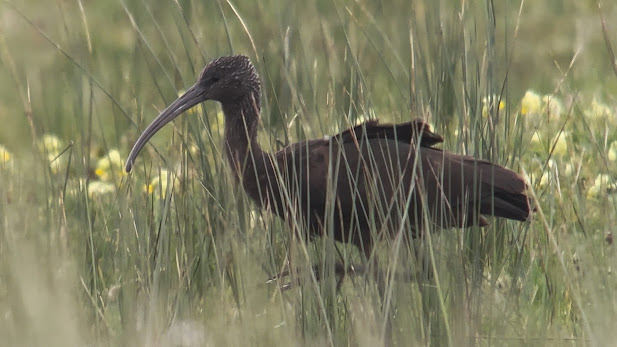
.jpg)
.jpg)


















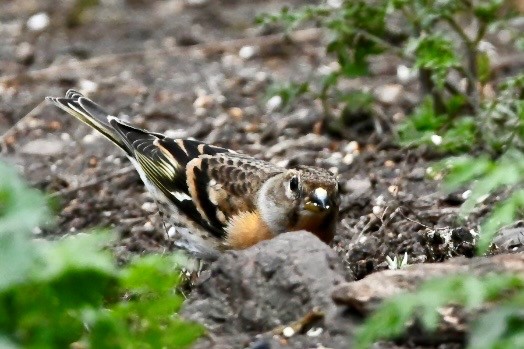
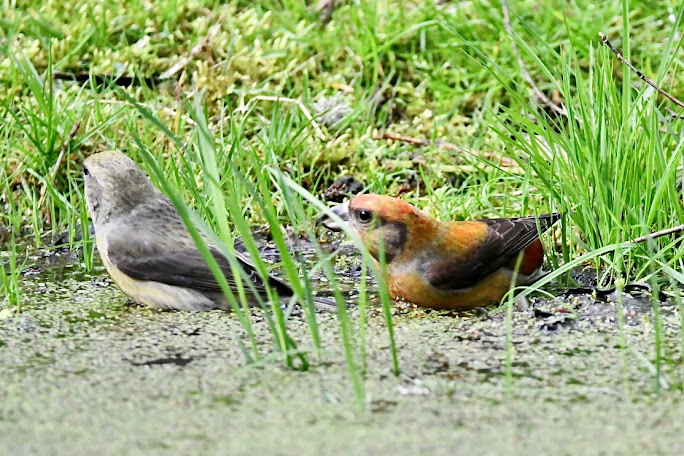











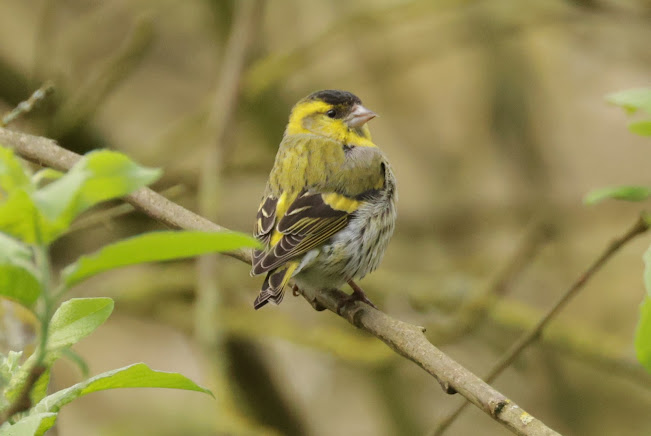






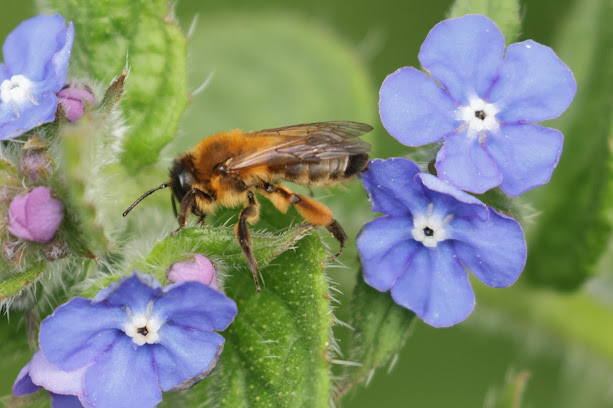






.JPG)



